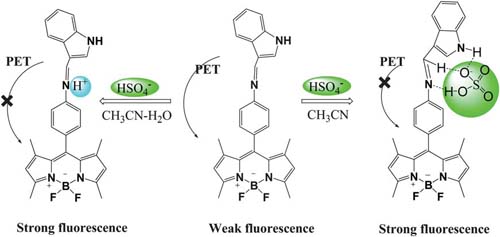Abstract: A new fluorescent receptor 1 for anions has been synthesized by the combination of BODIPY dye and indole moiety. The binding and sensing abilities of receptor 1 toward various anions have been studied by absorption, emission and 1H NMR titrations spectroscopies. Receptor 1 could act as a highly selective ‘‘Off–On’’ fluorescent sensor for hydrogen sulfate anion in CH3CN solvent and CH3CN–H2O medium. The fluorescence response of receptor 1 toward HSO4- in CH3CN solvent could be due to the suppressed PET (photo-induced electron transfer) process induced by the multiple hydrogen bonding interactions between receptor 1 and HSO4-. In CH3CN–H2O medium, the HSO4- -induced change is mainly the consequence of a simple protonation of the CH]N– moiety of receptor 1, which inhibited the PET process and "turned on" the fluorescence of 1.
 |
| Proposed binding mode and sensing mechanism of receptor 1 with hydrogen sulfate anions. |
Conclusion: In summary, we have constructed a new BODIPY based ‘‘Off–On’’ fluorescent sensor for hydrogen sulfate anions based on the PET mechanism. Given the fact that it is relatively challenging to develop fluorescent sensors for anions with a fluorescence turned on response, the strategy for the sensor design presented here may contribute to the development of more efficient ‘‘Off–On’’ anion chemosensors.
